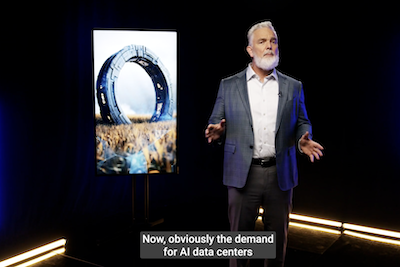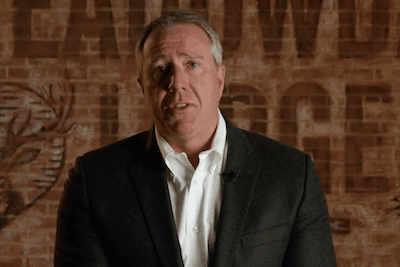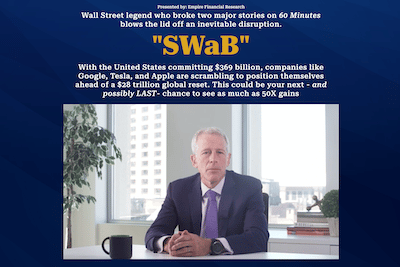In his latest presentation, Alex Koyfman says there’s a “climate war” about to erupt that could bring about the “end of plastic.” And apparently, he’s discovered “one off-the-radar investment” that could help you turn “every $10,000 into $127,200.”
What’s he talking about? Is plastic really going to “end,” as he suggests? And if so, could his recommendation really help you retire rich?
These are some of the questions we’ll be exploring in this article. First, I’ll walk you through Koyfman’s “end of plastic” prediction. Then I’ll reveal the stock I think he’s teasing, and show you what he’s selling, to help you decide if it’s legitimate and worthwhile.
Sound good?
Okay, let’s get right into it.
Breaking Down “The End of Plastic” Teaser
Alex Koyfman begins the “End of Plastic” presentation by stating that “few people are aware” that a United Nations document called the Paris Agreement is “about to trigger a massive economic disruption.”
And he says that, according to Princeton University, $2.5 trillion could change hands over the next few years because of this disruption.
He also says he knows of a “unique way” for regular investors to “tap into this flood of cash” that could help you “multiply your money many times over.”
Is there any truth to what he’s saying?
Admittedly, I do feel that some of the claims are pretty bold. But at the same time, Koyfman doesn’t appear to be making stuff up out of thin air.
For example, the document he’s referring to, the Paris Agreement, is a real thing.
What is it?
According to the United Nations Climate Change website, the Paris Agreement is a “legally binding international treaty on climate change” that was adopted by 196 Parties in late 2015.
What’s the goal of the agreement?
Alex Koyfman says the agreement’s goal is to limit global warming to “well below 1.5 degrees Celsius.” However, according to the UNCC website I just linked to, its goal is to “limit global warming to well below 2, preferably to 1.5 degrees Celsius.”
So there seems to be a slight mismatch between what Koyfman says and what the UNCC site states. But either way, the goal of the agreement is to limit global warming.
How is this a “$2.5 trillion opportunity,” as the presentation suggests?
It seems Koyfman’s referring to a Princeton study that suggests that $2.5 trillion in additional investments will be needed over the next decade to reach a net-zero carbon U.S. by 2030.
So he’s essentially saying that $2.5 trillion is the amount that could be spent on meeting the goals set in the Paris Agreement. Goals which, according to Alex, we’re not on target to meet.
In the presentation, he points out that global temperatures have increased, and CO2 emissions have only slightly decreased since 2016 (which appears to be true based on my research).
And he says this is why “some members of the Paris Agreement plan to take radical measures” like forcing other countries into compliance through carbon tariffs.
Leaders from Canada, Australia, and the European Union are currently discussing how to force other countries into compliance…
Regardless of whether they like it or not.
The way to do it is simple: carbon tariffs
Source: https://secure.angelpub.com/o/web/349234
As a result, Koyfman says countries that don’t find a way to reduce their carbon emissions will suffer due to import tariffs. And this, in turn, could limit their income since it would make their products more expensive to export to other countries.
And this is what the “climate war” he refers to is all about – the global fight to reduce emissions. In Koyfman’s words, “every country will do whatever it takes to be the first to reduce emissions.”
Why? Because he says if they don’t, they’ll risk bankruptcy.
He makes a good point, too.
But does that mean his recommendations will help you turn every $10,000 into $127,200?
To help answer that, let’s dig a little deeper. Specifically, let’s look at the role plastic plays in all of this since the central part of his thesis is that plastic is going to “end.”
Will “The End of Plastic” Help You Retire Rich?
During the presentation, Alex Koyfman talks about how harmful plastic is to the environment and how “bioplastic” could be the solution. Specifically, he talks about how “tiny bioplastic companies” like the one he recommends are “potential millionaire-makers.”
And while he doesn’t promise this, the title of a report he created (The End of Plastic — Retire Rich on the Company Saving the World) suggests that his stock is aimed at helping you retire rich.
We’ll discuss the stock I think he’s teasing shortly.
But for now, the question is, is plastic really going to come to an end?
And if so, will bioplastic take its place?
I don’t think anyone can answer these questions with absolute certainty, but Koyfman seems to believe this will be the case.
During the presentation, he talks about how harmful plastic is to the environment—everything from how it’s made to how it’s disposed of.
For example, he says plastic is one of the most energy-intensive materials to produce and that it contributes to over 200 million tons of carbon dioxide each year. He also says it’s expected to account for 56 gigatons of carbon between now and 2050.
Those are staggering numbers.
And sadly, based on what I learned in this article on debrisfreeoceans.org, it’s true. The earth is being ruined by plastic in more ways than one. And the article I just linked to does a great job of explaining why this is the case. So I recommend checking it out if you want to learn more.
Anyway… I think it’s pretty clear that plastic sucks.
Check.
And while it’s far from certain, I guess you could argue that, given how harmful plastic is to the environment and the potential tariffs Koyfman talks about, it could be phased out.
But what about bioplastic? Will it be the replacement?
To answer this, let’s start with what bioplastic is.
Bioplastics are plastic materials produced from renewable biomass sources, such as vegetable fats and oils, corn starch, straw, woodchips, sawdust, recycled food waste, etc.
So, the key difference is that bioplastic is made from renewable sources that are easily broken down when disposed of. Whereas “regular plastic” that’s made from fossil fuels like petroleum or natural gas can take centuries to break down, which is why it’s often burned instead.
Whether or not it can replace plastic, however, is another story.
And it seems not everyone is convinced this will be the case.
Here’s what an article on the Yale School of the Environment website states:
Bioplastics are being touted by industry marketers as the solution to plastics pollution. But the idea that bottles and packaging made of plant-based material can simply be discarded and then break down and disappear is false – recycling and reuse are the only strategies that can work.
Based on that article and other research I’ve done on this subject, it seems clear that some experts believe that recycling is more important than the “plastic vs. bioplastic” debate.
Still, I think Koyfman makes some good points in the presentation. And while bioplastics may not be the answer, I find it hard to imagine them not being better than plastic made from fossil fuels.
In any case, Koyfman states that for plastic to be replaced, the new material would need to be “strong, cheap and easy to make.”
And he says there’s “one surprising application” that “perfectly demonstrates” whether a plastic alternative meets his criteria – coffee pods.
As in the pods that go into a Nespresso coffee machine.
He suggests that this is a great example because of the heat and pressure these pods are under. And says there’s one “tiny company” that has figured out how to make coffee pods from a “100% biological plastic alternative” that took them five years to develop.
He also says that coffee pods are just the beginning for this company.
Apparently, this was just a way for them to “showcase” their ability to create a viable plastic alternative and that they’re aiming at the more prominent global plastic market.
Long story short, he says the potential is massive:
Like I said, the global plastic market is valued at $579 billion.
If this company captures just 1% of this entire industry, it could grow by an astonishing 6,896%, according to my calculations.
That’s enough to turn every $5,000 invested into $349,800…
And a $15,000 investment could be enough to make you a millionaire…
Handing you up to $1,049,400 in cold, hard cash.
These are some bold statements. And I wouldn’t join any service expecting to make these types of gains because, while possible, they are well above average.
That said, Koyfman does recommend small-cap companies, and if you choose the right company, it’s possible to see higher than average gains compared to betting on large caps.
What company is he teasing?
Read on.
What Is Alex Koyfman’s “End of Plastic” Stock Pick?
Alex Koyfman doesn’t reveal the stock he’s recommending in the presentation. Instead, he details his pick in a report titled “The End of Plastic — Retire Rich on the Company Saving the World.”
He does leave some clues in the presentation, though. And after taking a close look at these clues, I think I may know what company he’s talking about.
Here’s an overview of the clues he provides (in no particular order):
“I’m talking about a 100% biological plastic alternative that uses no fossil fuels at all and that’s fully compostable within a few weeks.”
“And that essentially vanishes from the face of the Earth in as little as 35 days, leaving no waste and emitting practically no carbon.”
“Developing this bioplastic took this company five years and cost an astonishing $35 million.”
“With 10 patent applications filed, the company will soon have an insurmountable moat around its proprietary technology…”
“Wealthy venture capitalists and the Canadian government pumped all that cash into this firm while it was still private.”
“You see, this firm is tiny. The stock is trading at a $100 million market cap as of this publication.”
Based on my research, I think the company Koyfman is teasing is NEXE Innovations.
It was pretty easy to figure this one out. All I did was Google “Canadian bioplastic coffee pod company,” which brought me to this article on newswire.ca.
From there, connecting the dots was a piece of cake.
Anyway, here’s an overview of why I think it’s NEXE Innovations:
- The company says it “designs, manufactures and commercializes fully compostable, plant-based materials for everyday consumer products” and currently specializes in coffee pods. One of these, the “NEXE POD,” breaks down in about 35 days.
- The Canadian government has invested (at least) $1 million into the company.
- The company website says its “backed by 5 years of scientific research” and $31 million of investment and financing. Koyfman said $35 million but it’s close, and there could be a reason for the difference like the site hasn’t been updated or something.
- Regarding patents, the company’s latest investor presentation states that their “IP firm has identified at least 20 patent applications” which includes the ones they own.
- NEXE Innovations trades on the TSX (NEXE.V) and OTC (NEXNF) markets. And the market cap is around $66 million and $54 million respectively at the time of writing (October 8, 2021).
I’ll leave it up for you to decide if you think my guess is correct and whether or not you believe this company is a good investment. But I think this is the company based on my research.
To find out for sure if this is the company Alex Koyfman is teasing, you’ll need to read his report (The End of Plastic — Retire Rich on the Company Saving the World), which he gives as a bonus to those who join his advisory service, Microcap Insider, which is all about investing in microcaps.
What’s a microcap?
Microcap stocks are U.S. public companies with a market cap of $50 million to $300 million. If you’re right about a microcap stock, the upside can be huge. However, given these are much smaller companies than large-cap companies, the risks can also be higher.
These stocks can also be highly volatile, meaning relatively low buy or sell pressure can cause the share price to fluctuate significantly.
And NEXE is a good example of this. Based on Yahoo Finance, the stock (NEXE.V) was trading at a high of around $5 in February of this year and is now trading at about $0.69. Of course, that doesn’t mean it’s not a good company, but it does go to show how volatile small stocks can be.
I don’t own shares of NEXE Innovations, but I have experienced massive volatility in my portfolio over the years. Sometimes it’s exciting. Other times it’s terrifying. So I think it’s always important to do your own research to understand the risks and work out what’s right for you.
In any case, Alex Koyfman seems to believe the stock he’s interested in (whatever it is) is going much higher. And suggests that November 12, 2021, is an important date.
Update (February 16, 2022): It has recently come to my attention that this presentation has been updated. The date in Koyfman’s presentation is now November 1, 2022. And the following has been updated to reflect this.
What’s Happening On November 1, 2022?
According to Alex Koyfman, there’s a big event taking place on November 1, 2022. And he says that’s the date shares of the company he’s recommending could “go through the roof.”
Here’s how he puts it:
“It’s because of a big event taking place on November 1, 2022…”
“That’s the date when shares of this little-known company could go through the roof.”
So what’s happening on November 1?
It’s the date of the 27th UN Climate Change Conference of the Parties (COP 27). And it’s all about bringing parties together to tackle climate change.
Koyfman says this is the day “carbon tariffs could start springing up around the world” and cause prices of carbon-intensive goods to soar.
In other words, it’s more or less the day he believes his thesis could kick into high gear.
Of course, there’s no guarantee anything significant will happen to the company he’s recommending on November 1, but at the very least, it’s relevant to his thesis.
In any case, to find out what company Koyfman’s teasing, and why, you’d need to join Microcap Insider. So let’s take a look at what it’s all about.
Overview of Microcap Insider
Microcap Insider is a stock advisory service run by Alex Koyfman of Angel Publishing.
The service is focused on microcap stocks (U.S. stocks between $50 million to $300 million). As I explain in my full review of Microcap Insider, it centers around tech and biotech companies.
Koyfman says he looks for the hottest, most aggressively expanding companies in these sectors before they start picking up attention from mainstream media.
And as a subscriber, you get access to all of his latest stock picks, research, and insights within the monthly newsletters. As well as real-time buy alerts and some bonus reports.
As of writing, if you join through the presentation, there are three bonus reports:
- The End of Plastic — Retire Rich on the Company Saving the World
- Netflix for the Mind: A Trillion-Dollar Consumer Tech Revolution
- Penny Stock Quick-Start Guide
How much does it cost to join?
The cost of signing up to Microcap Insider through this presentation is $1,999. Angel Publishing, the company behind this, offers a 90-day money-back guarantee on this, too.
Recommended: Go here to see my #1 rated stock advisory of 2024
Who’s Alex Koyfman?
Alex Koyfman is behind the “End of Plastic” presentation and lead editor of Microcap Insider. According to the Angel Publishing website, he launched Microcap Insider in 2014.
The website says he immigrated to the U.S. from Soviet Russia in the early 1980s and that his background is in law. However, he apparently decided to get into finance after leaving law school and was “trading actively by his late teens.”
From what I understand, his primary focus has been chiefly on early-stage public companies, the sort of companies he shares with subscribers of Microcap Insider.
In the presentation, he describes his investing approach as “entirely different from anything you’ve ever heard of.” And says this is because he takes advantage of the “tiniest stocks with hands down the greatest growth potential.”
What’s Angel Publishing?
Angel Publishing is a financial publishing company, and it’s behind Microcap Insider and other services like The Wealth Advisory, Bull and Bust Report, and Technology and Opportunity, which I’ve written about on this site (see links).
Aside from Alex Koyfman, some of the other gurus that work at Angel Publishing include Keith Kohl, Birton Ryle, Christian DeHaemer, and Jason Williams.
Is it legit?
From what I can tell, Angel Publishing is a legitimate company. It’s based in Baltimore, MD, and it looks like they’ve been in business since the early 2000s.
I can’t vouch for all of their services, and like any company, there are some complaints out there, but it doesn’t look like it’s scamming anyone.
Bottom Line
Alex Koyfman’s “End of Plastic” presentation is all about how he believes plastic could be replaced with bioplastic as the new ESG (Environmental, Social, and Governance) agenda continues to expand across the globe, especially as it relates to carbon tariffs.
Whether or not Koyfman’s thesis plays out as he expects is anyone’s guess. But he does make some good points in the presentation regarding the need for a plastic replacement.
So the “End of Plastic” presentation isn’t a scam in my opinion.
That said, I think some of the claims he makes, like turning “every $5,000 invested into $349,800,” for example, are very bold. I guess anything is possible, but I don’t think it’s a good idea to rush into something like Microcap Insider expecting to make that sort of money.
Because at the end of the day, investing is risky. Especially when investing in small stocks because large returns might be possible, but so are significant losses.
In any case, that’s it from me. I hope you found this article helpful, and feel free to share your thoughts about the presentation in the comments below.












Please note: By submitting a comment using the above comment form, you confirm that you agree with the storage and handling of your data by this site as detailed in our Privacy Policy.